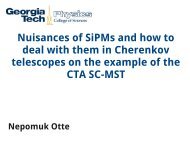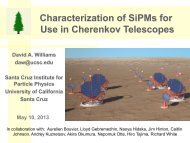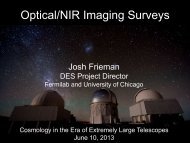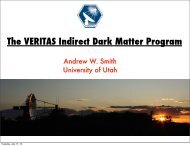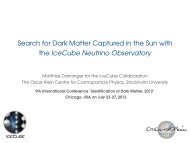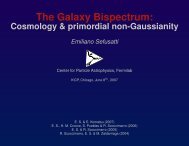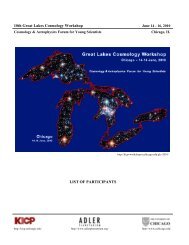RICHARD SALDANHA IDENTIFICATION OF ... - KICP Workshops
RICHARD SALDANHA IDENTIFICATION OF ... - KICP Workshops
RICHARD SALDANHA IDENTIFICATION OF ... - KICP Workshops
Create successful ePaper yourself
Turn your PDF publications into a flip-book with our unique Google optimized e-Paper software.
PRINCETON<br />
UNIVERSITY<br />
26th July 2012<br />
<strong>RICHARD</strong> <strong>SALDANHA</strong><br />
GRAN<br />
SASSO<br />
<strong>IDENTIFICATION</strong> <strong>OF</strong> DARK MATTER 2012
•<br />
•<br />
•<br />
DarkSide Program<br />
Direct detection search for WIMP dark matter<br />
Based on a two-phase argon time projection<br />
chamber (TPC)<br />
Design philosophy based on having very low<br />
background levels that can be further reduced<br />
through active suppression, for background-<br />
free operation<br />
2
DarkSide Program<br />
Multi-stage program at Gran Sasso National Laboratory<br />
DarkSide 10<br />
Currently running full prototype detector<br />
DarkSide 50<br />
First physics detector<br />
Physics goal ~ 10 -45 cm 2<br />
DarkSide G2<br />
Multi-ton detector<br />
Physics Goal ~ 10 -47 cm 2<br />
+ multiple smaller test setups and prototypes 3
7x 3” PMTs<br />
7x 3” PMTs<br />
DarkSide 10<br />
TPB + ITO coated quartz window<br />
Acrylic cylinder<br />
with TPB-coated reflector<br />
Flexible PCB field cage<br />
TPB + ITO coated quartz window<br />
4
DarkSide 10<br />
First designed, built and<br />
operated at Princeton University<br />
Moved underground at Gran<br />
Sasso to operate in a low-<br />
background environment<br />
Dedicated campaigns to test light<br />
collection, high voltage and other<br />
technical solutions for future<br />
5<br />
detectors
Signal Amplitude [a.u.]<br />
10 5<br />
10 4<br />
10 3<br />
10 2<br />
10<br />
1<br />
Light Yield Measurements<br />
Single photoelectron spectrum<br />
0 50 100 150 200 250<br />
<br />
Energy L.Y. Resolution<br />
(σ)<br />
122 8.87 [%] 5.2<br />
Figure 2: Example of the charge response spectrum of a single PMT<br />
exposed to low-occupancy laser flashes. The horizontal axis measures<br />
charge in integrated digitizer counts (counts · samples), where<br />
1 count · sample [keV] corresponds to a PMT [p.e. output/ charge keV] of 0.0078 pC.<br />
The colored curves represent components in the fit function used in the<br />
calibration. Green: pedestal. Dashed Magenta: Gaussian and exponential<br />
terms of the single-p.e. model convolved with pedestal. Solid<br />
Magenta: full single-p.e. response convolved with pedestal. Solid<br />
Blue: 2-p.e response. Dotted Blue: ≥ 3-p.e. response. Solid Red:<br />
Sum of all components.<br />
511 8.78 3.4<br />
662 9.08 3.1<br />
have modeled the n-photoelectron response of the system<br />
as<br />
1275 8.60 2.9<br />
fn(x) = ρ(x) ∗ ψ n∗<br />
1<br />
(x) (2)<br />
AVERAGE 8.9 +/- 0.4<br />
where ρ denotes the zero photoelectron response<br />
(pedestal), ∗ is a convolution, and ψ n∗ is the n-fold<br />
The single photoelectron response<br />
of each tube was measured using<br />
Detector light yield was measured<br />
6<br />
a fast, pulsed laser<br />
using a series of external γ<br />
sources at null field<br />
Rate [counts/sec/10 p.e.]<br />
0.20<br />
0.15<br />
0.10<br />
0.05<br />
0<br />
arXiv:1204.6218 [astro-ph.IM]<br />
137 Cs Spectrum<br />
χ 2 /ndf<br />
Mean<br />
Sigma<br />
662 keV Line<br />
169.7/115<br />
6010 ± 1.8<br />
186.2 ± 1.9<br />
0 2000 4000 6000 8000 10000 12000<br />
Detected scintillation light [p.e.]
S1 and S2 signals<br />
With drift fields on, the recoil energy is divided into a<br />
light (S1) and charge (S2) signal<br />
Erec ∝ S1 + k·S2<br />
S1 and S2 are anti-correlated<br />
The sum is independent of the drift field<br />
S1<br />
7
Neutron Calibration<br />
Data was taken with an external Am-Be neutron source<br />
Log (S2/S1)<br />
3<br />
2<br />
1<br />
0<br />
-1<br />
with the detector in TPC mode<br />
-2<br />
0 0.2 0.4 0.6 0.8 1<br />
F90<br />
Background<br />
3<br />
10<br />
2<br />
10<br />
10<br />
1<br />
-2<br />
0 0.2 0.4 0.6 0.8 1<br />
F90<br />
Am-Be Source<br />
Study of discrimination currently underway<br />
Log (S2/S1)<br />
3<br />
2<br />
1<br />
0<br />
-1<br />
3<br />
10<br />
2<br />
10<br />
10<br />
1<br />
8
•<br />
•<br />
•<br />
•<br />
•<br />
DS-10 Performance<br />
Compare performance of different reflectors for<br />
light collection<br />
Detector run with both 3M foils (~ 9 p.e./keVee) and<br />
highly crystalline PTFE (~ 7 p.e/keVee)<br />
Study feasibility of ITO coatings<br />
Test HHV system (feedthroughs, grid etc.)<br />
Detector running without problems at nominal field<br />
configuration (1 kV/cm drift, 3.8 kV/cm extraction)<br />
Perform calibration of detector<br />
Calibrations performed with external γ and neutron<br />
sources. 83 Kr source to be implemented soon<br />
Optimize field configuration of TPC<br />
Different field configurations under consideration 9
10<br />
DarkSide 50<br />
Radon-free clean room<br />
Instrumented water tank<br />
Liquid scintillator<br />
Inner detector TPC<br />
(Underground argon)
•<br />
•<br />
•<br />
External Water tank<br />
80 PMTs within Borexino<br />
CTF<br />
(11m dia. x 10 m high)<br />
Acts as a muon and<br />
cosmogenic veto<br />
(~ 99% efficiency)<br />
Provides passive gamma<br />
and neutron shielding<br />
11
•<br />
•<br />
Liquid Scintillator Veto<br />
Liquid scintillator allows<br />
coincident veto of neutrons in<br />
the TPC and provides in situ<br />
measurement of the neutron<br />
background rate<br />
4 m diameter sphere containing 1:1 PC + TMB scintillator<br />
Instrumented with 110 8” PMTs<br />
12
•<br />
•<br />
•<br />
13<br />
Borated Liquid Scintillator<br />
High neutron capture cross section on<br />
boron allows for compact veto size<br />
Capture results in 1.47 MeV α particle<br />
- detected with high efficiency<br />
Short capture time (2.3 μs) reduces<br />
dead time loss<br />
Veto Efficiency<br />
Radiogenic Neutrons > 99.5%*<br />
Cosmogenic Neutrons > 95%<br />
Nuclear Instruments and Methods A 644, 18 (2011)<br />
*60 μs veto window (2% dead time)
Liquid Scintillator Tank<br />
CTF tank has been<br />
emptied<br />
Liquid scintillator tank<br />
assembly has recently<br />
been completed 14
Inner detector TPC<br />
19x 3” PMTs<br />
TPB + ITO coated quartz diving bell<br />
Copper field cage rings<br />
TPB coated Highly Crystalline PTFE<br />
~ 50 kg LAr<br />
TPB + ITO coated quartz window<br />
19x 3” PMTs<br />
15
39 Ar<br />
• Intrinsic 39 Ar radioactivity in atmospheric<br />
argon is the primary background for argon-<br />
based detectors<br />
• 39 Ar activity sets the dark matter detection<br />
threshold at low energies (where pulse<br />
•<br />
shape discrimination is ineffective)<br />
Size of large argon TPC’s is limited by the<br />
pileup rate induced by 39 Ar<br />
16
Underground Argon<br />
• 40 Ar is mostly produced underground<br />
(through decay of 40 K)<br />
• 39 Ar is cosmogenic, produced by 40 Ar(n,2n)<br />
interactions in the atmosphere<br />
•<br />
Argon that has remained underground can<br />
therefore have extremely low levels of 39 Ar<br />
• However, 39 Ar can also be produced underground<br />
through 39 K(n, p) interactions, where the neutron<br />
originates from (α, n) reactions.<br />
39 Ar/ 40 Ar depends on the local concentration of 238 U and 232 Th17
Underground Argon<br />
Underground Argon<br />
from CO2 plant in<br />
Cortez Colorado VPSA system (Cortez)<br />
0.5 kg/day production<br />
110 kg produced so far<br />
CO2<br />
[%]<br />
N2<br />
[%]<br />
He<br />
CO2 Plant Output 96 2.4 0.4 0.06<br />
VPSA output ~ 0 40 55 5<br />
Cryogenic<br />
Distillation output<br />
arXiv:1204.6024 [astro-ph.IM]<br />
[%]<br />
Ar<br />
[%]<br />
~ 0 < 0.05 ~ 0 > 99.95<br />
Cryogenic Distillation system<br />
0.9 kg/day production<br />
70 - 81% efficiency<br />
~ 19 kg produced so far<br />
arXiv:1204.6061 [astro-ph.IM]<br />
18
Underground Argon Measurement<br />
Low background LAr<br />
detector was operated<br />
underground at KURF with<br />
both atmospheric and<br />
underground argon<br />
arXiv:1204.60111 [physics.ins-det]<br />
Underground<br />
Argon<br />
Atmospheric<br />
Argon<br />
39 Ar Depletion<br />
Factor<br />
Total Rate<br />
[mBq/100 keV]<br />
1.87 +/- 0.06<br />
108.8 +/- 0.4<br />
Estimated<br />
Background argon data at KURF. Rate<br />
[mBq/100 keV]<br />
1.5 +/- 0.2<br />
* +** ,** -** .** /***<br />
!"#$%&'(#)<br />
Background<br />
Subtracted Rate<br />
[mBq/100 keV]<br />
1.71 +/- 0.05 % < 0.65 % (95 CL)<br />
012#'345'(#)6<br />
7+<br />
/*<br />
/*<br />
7, /*<br />
78<br />
/*<br />
/*<br />
79<br />
7-<br />
!"#$%&:;
Expected Backgrounds<br />
Detector Element Electron Recoil Radiogenic Neutron Cosmogenic Neutron<br />
Backgrounds Recoil Backgrounds Recoil Backgrounds<br />
Raw After Cuts Raw After Cuts Raw After Cuts<br />
39 Ar (
Sensitivity<br />
21
22<br />
Augustana College, SD<br />
Black Hills State University, SD<br />
Drexel University, PA<br />
Fermi National Accelerator Laboratory, IL<br />
Princeton University, NJ<br />
Temple University, PA<br />
University of Arkansas, AR<br />
University of California, Los Angeles CA<br />
University of Houston, TX<br />
University of Massachusetts, Amherst, MA<br />
Virginia Tech, VA<br />
DarkSide Collaboration<br />
Joint Institute for Nuclear Research, Dubna<br />
Skobeltsyn Institute for Nuclear Physics, Moscow<br />
National Research Centre Kurchatov Institute, Moscow<br />
St. Petersburg Nuclear Physics Institute, Gatchina<br />
Laboratori Nazionali del Gran Sasso, Assergi<br />
Universita degli Studi and INFN, Genova<br />
Universita degli Studi and INFN, Milano<br />
Universita degli Studi and INFN, Perugia<br />
Universita degli Studi Federico II and INFN, Napoli<br />
Smoluchowski Institute of Physics, Krakow<br />
Institute of High Energy Physics, Beijing<br />
Institute of Nuclear Research, Kiev<br />
University College London, London



